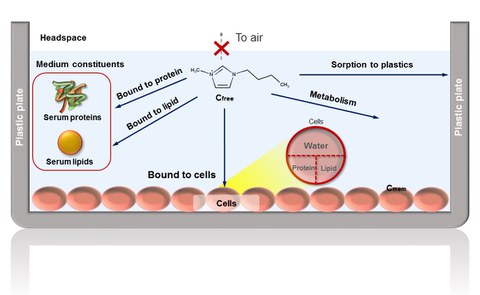ionische Substanzen (ionische Flüssigkeiten)

Partitioning of ionic liquids in cell-based assays
Ionische Flüssigkeiten (IL) gewinnen aufgrund ihrer anpassbaren physikalisch-chemischen Eigenschaften, die durch die Kombination von kationischen und anionischen Bestandteilen mit verschiedenen Substituenten erreicht werden, immer mehr an Bedeutung. Wegen ihres vernachlässigbaren Dampfdrucks und ihrer Nichtentflammbarkeit werden sie oft als "grüne" oder "nachhaltige" Chemikalien bezeichnet. Eine zunehmende Zahl von Studien über die Toxizität und biologische Abbaubarkeit von ILs zeigt jedoch, dass einige ILs sehr gefährlich sein können. In diesem Projekt konzentrieren wir uns auf mechanistische Untersuchungen der toxischen Wirkungsweisen einer breiten, strukturell vielfältigen Gruppe von ILs, um die Bewertung ihrer Umweltgefährdung zu unterstützen. Ein weiteres Ziel ist die Messung von Umwelt- oder physiologischen Verteilungseigenschaften wie dem Membran-Wasser- oder Protein-Wasser-Verteilungskoeffizienten. Zusammengenommen werden diese Ansätze ein besseres Verständnis des physiologischen und ökologischen Verhaltens dieser neuen Gruppe von Stoffen ermöglichen. Die Entwicklung von Modellen zur Vorhersage der Toxizität und des Bioakkumulationspotenzials von ILs wird in Zukunft ein proaktives Screening von neuen, noch unbekannten Stoffen ermöglichen.
Frei gelöste Konzentrationen (Cfree) sind in der Toxikologie ein genauerer Dosismaßstab, da sie die chemische Verteilung und Bioverfügbarkeit besser berücksichtigen als nominale Konzentrationen. Durch die Kombination von experimenteller Quantifizierung und Modellierung zeigt unsere neue Studie die zelllinienspezifischen Affinitäten von Kationen ionischer Flüssigkeiten auf und verbessert damit die Gefahrenbewertung und das Verständnis toxischer Wirkmechanismen. Diese Ergebnisse betonen die Bedeutung der Berücksichtigung von Cfree, um eine Unterschätzung der Toxizität zu vermeiden und Umweltrisiken besser vorherzusagen. Weitere Details finden Sie hier: Assessing Modes of Toxic Action of Organic Cations in In Vitro Cell-Based Bioassays: the Critical Role of Partitioning to Cells and Medium Components
Auf der Suche nach den toxischen Wirkmechanismen von ILs haben wir kürzlich das größte (Zyto-)Toxizitätsscreening in der Literatur durchgeführt: 45 ILs wurden in Reporter-Tests mit zwei Genen getestet: Nrf2-ARE-vermittelte Reaktion auf oxidativen Stress (AREc32) und Aryl-Kohlenwasserstoff-Rezeptor-Aktivierung (AhR-CALUX). Weitere Infos dazu finden Sie unter: The mode of toxic action of ionic liquids: Narrowing down possibilities using high-throughput, in vitro cell-based bioassays
Möchten Sie mehr über die Entwicklung umweltfreundlicherer und nachhaltigerer Chemikalien, einschließlich ionischer Flüssigkeiten, erfahren? Lesen Sie unsere neueste Veröffentlichung Toward the Proactive Design of Sustainable Chemicals: Ionic Liquids as a Prime Example
Ionische Flüssigkeiten können als alternative Pflanzenschutzmaßnahmen eingesetzt werden, die im Gegensatz zu herkömmlichen Pestiziden nicht direkt auf Insekten oder andere Krankheitserreger einwirken (und so zum Schutz der biologischen Vielfalt in landwirtschaftlichen Gebieten beitragen können), sondern die Pflanzen zur natürlichen Abwehr anregen. Weitere Informationen finden Sie in dem Artikel New bifunctional ionic liquid-based plant systemic acquired resistance (SAR) inducers with an improved environmental hazard profile
